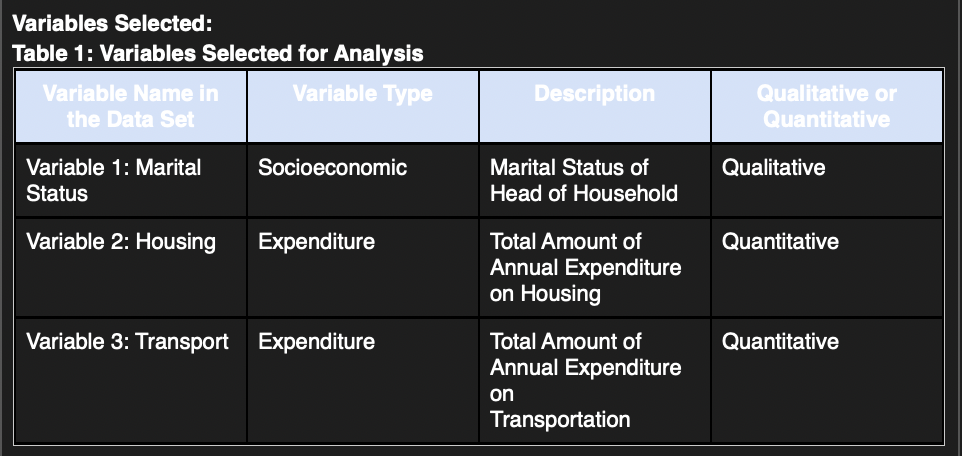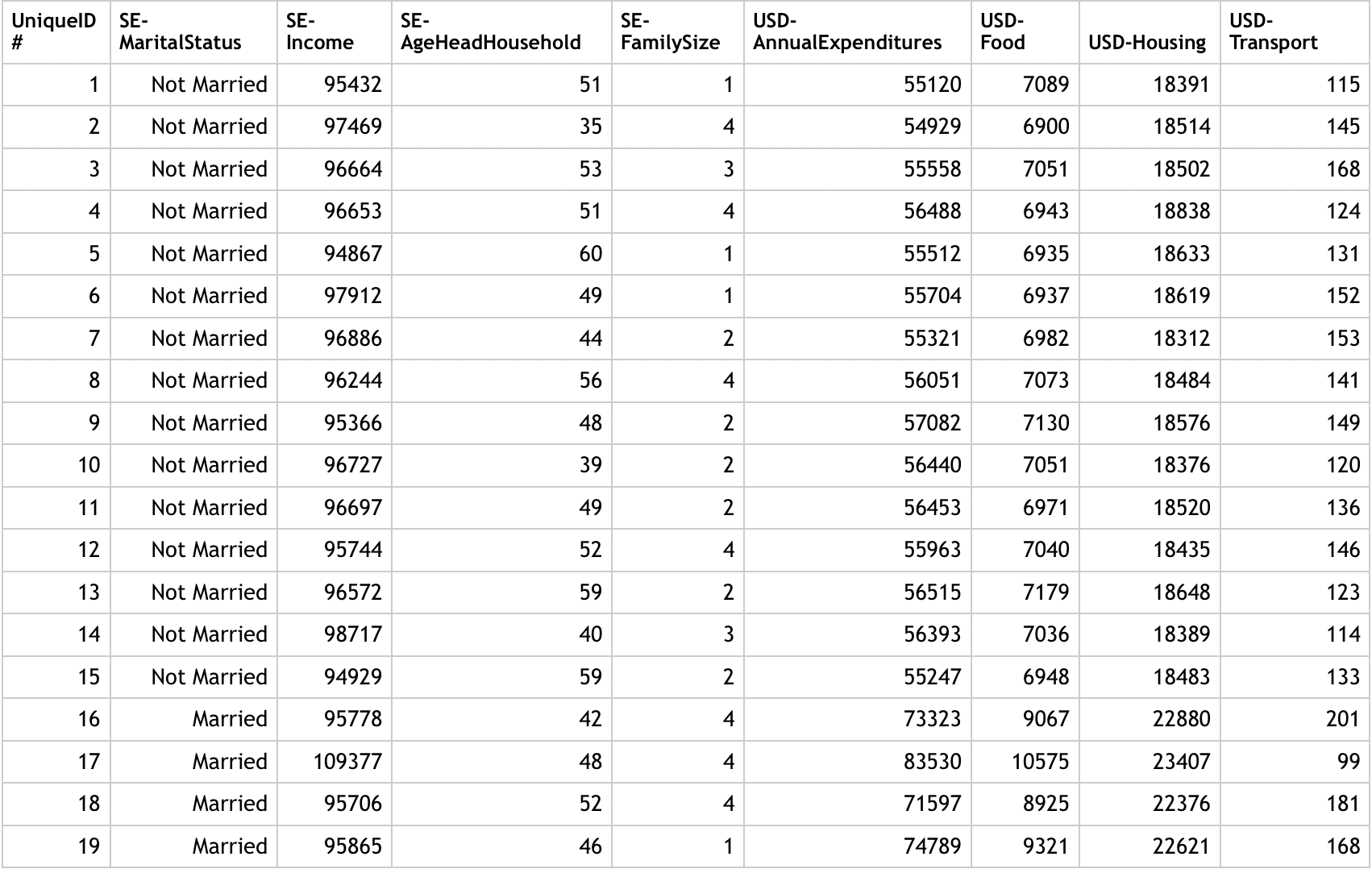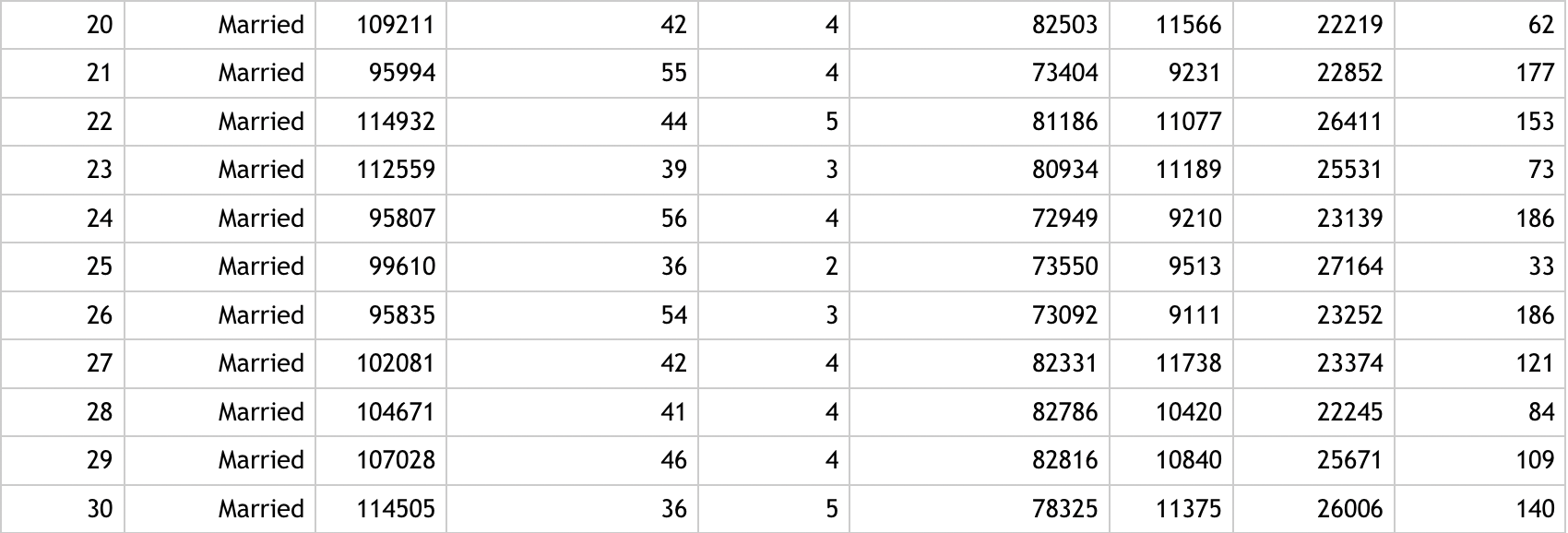I am struggling to complete from step 2 onwards
Variables Selected: Table 1: Variables Selected for Analysis Variable 1: Marital Socioeconomic Marital Status of Qualitative Status Head of Household Variable 2: Housing Expenditure Total Amount of Quantitative Annual Expenditure on Housing Variable 3: Transport Expenditure Total Amount of Quantitative Annual Expenditure on Transportation Data Analysis: 1. Confidence Interval Analysis: For one expenditure variable, select and run the appropriate method for estimating a parameter, based on a statistic (i.e., confidence interval method) and complete the following tabte (Note: Format follows Kozak outline): Table 2: Confidence Interval Information and Results Name of Variable: Transportation State the Random Variable and Parameter in Words: Random Variable: Here random variable X is the total amount of annual expenditure on transportation Parameter: Here parameter of interest is the average amount of annual expenditure on transportation Confidence interval method including confidence level and rationale for using it: The confidence interval for sample mean was used because the variable of interest is Quantitative. Therefore, I will use a 95% confidence level on my calculations. State and check the assumptions for confidence interval: A single confidence interval analysis was run for this test. Method Used to Analyze Data: The null hypothesis will prove a maiority of households with more income than Find the sample statistic and the confidence interval: Based on my calculations with my 95% confidence interval using a confidence interval calculator webpage, I saw that the sample mean of transportation expenditures is between 120 and 148, based on 30 samples. Further the standard error would be about 7.006 and the margin of error about 13.73. Statistical Interpretation: After looking at all my calculations, I have come to the conclusion that my calculations are true. 2. Hypothesis Testing: Using the second expenditure variable (with socioeconomic variable as the grouping variable for making two groups), select and run the appropriate method for making decisions about two parameters relative to observed statistics {i.e., two sample hypothesis testing method) and complete the following table (Note: Format follows Kozak outline): Table 3: Two Sample Hypothesis Test Analysis Research Question: Two Sample Hypothesis Test that Will Be Used and Rationale for Using It: State the Random Variable and Parameters in Words: State Null and Alternative Hypotheses and Level of Significance: Method Used to Analyze Data: Find the sample statistic, test statistic, and p-yalue: Conclusion Regarding Whether or Not to Reject the Null Hypothesis: Part B: Results Write Up Confidence Interval Analysis: Two Sample Hypothesis Test Analysis: Discussion: UniquelD SE- SE- SE- SE- USD- # USD- USD- MaritalStatus Income AgeHeadHousehold FamilySize AnnualExpenditures Food USD-Housing Transport Not Married 95432 51 55120 7089 18391 115 2 Not Married 97469 35 4 54929 6900 18514 145 W Not Married 96664 53 W 55558 7051 18502 891 4 Not Married 96653 51 4 56488 6943 18838 124 Not Married 94867 60 55512 6935 18633 131 6 Not Married 97912 49 55704 6937 18619 152 7 Not Married 96886 44 2 55321 6982 18312 153 8 Not Married 96244 56 4 56051 7073 18484 141 9 Not Married 95366 48 N 57082 7130 18576 149 10 Not Married 96727 39 N 56440 7051 18376 120 11 Not Married 96697 49 N 56453 6971 18520 136 12 Not Married 95744 52 4 55963 7040 18435 146 13 Not Married 96572 59 N 56515 7179 18648 123 14 Not Married 98717 40 W 56393 7036 18389 114 15 Not Married 94929 59 N 55247 6948 18483 133 16 Married 95778 42 4 73323 9067 22880 201 17 Married 109377 48 4 83530 10575 23407 99 18 Married 95706 52 4 71597 8925 22376 181 19 Married 95865 46 74789 9321 22621 168\f












